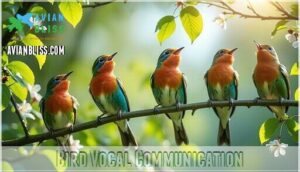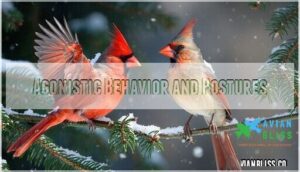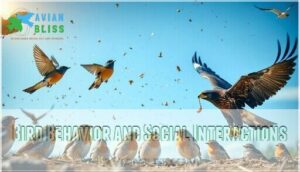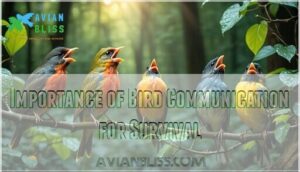This site is supported by our readers. We may earn a commission, at no cost to you, if you purchase through links.

They warn each other of predators, attract mates, and even teach their young essential survival skills.
By understanding these communication secrets, you’ll gain insight into the intricate social lives of birds, and that’s just the beginning of uncovering the amazing world of bird communication, where every chirp, song, and display holds a secret waiting to be discovered.
Table Of Contents
- Key Takeaways
- What is Bird Communication?
- Bird Vocal Communication
- Bird Visual Communication
- Bird Body Language and Postures
- Bird Behavior and Social Interactions
- Bird Communication in Social Groups
- Long-Distance Communication of Birds
- Importance of Bird Communication for Survival
- Frequently Asked Questions (FAQs)
- How are birds used for communication?
- What do birds do to communicate?
- What birds are known for communication?
- What are the four birds of communication?
- How do birds communicate with each other?
- What is Bird communication?
- Do you know the true meaning behind how birds communicate?
- Do wild birds communicate with humans?
- What are bird behavior and communication patterns?
- How do nocturnal birds communicate?
- Conclusion
Key Takeaways
- You’ll find that birds communicate through various methods, including vocalizations, visual displays, and body language, to convey messages about survival, interaction, and ecosystem roles.
- Birds use different types of vocalizations, such as songs and calls, to attract mates, warn of predators, and communicate with each other, and they even have regional dialects and mimicry abilities.
- You’ll discover that bird communication is essential for their survival, as it helps them find food, avoid predators, and attract mates, and it’s also crucial for raising their young and teaching them survival skills.
- By understanding bird communication, you’ll learn that birds are able to convey complex information and express themselves effectively through a range of signals, including vocalizations, visual displays, and chemical signals, which are all vital for their social interactions and daily lives.
What is Bird Communication?
You’re about to learn what bird communication is, and it’s fascinating to see how birds use various methods to convey messages.
Birds communicate in fascinating ways to convey messages and survive.
As you explore this topic, you’ll discover that birds communicate through vocalizations, visual cues, and chemical signals to survive, interact, and thrive in their environments, which is a fascinating aspect of their behavior.
Types of Bird Communication
You’ll discover birds use various methods to communicate, including:
- Vocal signals like bird songs and calls
- Visual displays with colorful plumage
- Tactile signals and chemical cues for avian communication, utilizing mimicry deception and interspecies communication with regional dialects in bird vocalization.
Birds also use scent marking strategies for territorial defense.
The methods of communication are diverse and include complex strategies such as regional dialects in bird vocalization.
Importance of Bird Communication
You’re about to uncover the importance of bird communication, which gives them a survival advantage.
Impact on ecosystem health and informing conservation efforts are crucial aspects of this field, while providing valuable behavioral insights into social learning and avian communication.
Highlighting the significance of bird vocalization and behavior in animal communication is essential for understanding the complex interactions within ecosystems.
Bird Vocal Communication
You’re about to explore the fascinating world of bird vocal communication, where birds use songs and calls to convey important messages.
As you learn about bird vocal communication, you’ll discover how birds use different types of vocalizations to attract mates, warn of predators, and communicate with each other.
Songs and Calls
You’ll find bird songs and calls are complex, with regional dialects and mimicry deception.
Birds learn vocalizations early, using alarm calls to warn others, showcasing song complexity and avian communication skills through distinctive bird vocalizations, including various bird songs and bird calls, which demonstrate avian communication skills.
Variability in Vocalizations
Birdsong isn’t just noise; it’s a world of variability. Think of birds as nature’s musicians.
You’ll find dialect differences, like accents, and environmental influence tweaks their tunes. Mimicry abilities let them learn from others.
Each bird has individual signatures, making its song unique. Contextual variations mean the same song can say different things.
This is all part of avian communication. You can hear it in bird songs and bird calls. Bird language is complex!
- The joy of a dawn chorus.
- The relief of a warning call.
- The wonder of mimicry.
Learning and Development of Vocalizations
Ever wonder how birds learn their tunes? It’s like they’re taking voice lessons! Young birds mimic adults to master their species’ songs.
This song learning process is like kids scribbling before writing. Environment and social interaction shape these bird calls.
Here’s how avian communication works:
- Listening: They hear adult bird songs.
- Practicing: Birds imitate sounds.
- Adjusting: They tweak tunes through sensorimotor learning.
- Socializing: Birds interact, shaping bird dialects.
Many resources are available to assist with bird song education. Vocal plasticity is key in song acquisition and mimicry development, and it’s all about how birds learn to sing their species’ songs through social interaction.
Individual Variation in Vocalizations
You notice songbirds have unique "dialects". This is due to Song Uniqueness and Dialect Evolution, influenced by environment and experience, with Genetic Influence on Learned Vocals, showcasing bird dialects and birdsong vocalizations.
| Vocalizations | Dialects | Bird Communication |
|---|---|---|
| Learned Vocals | Song Uniqueness | Mimicry Impact |
| Genetic Influence | Dialect Evolution | birdsong |
| Environment | bird dialects | Vocalizations |
The table outlines the relationship between Vocalizations, Dialects, and Bird Communication, highlighting the impact of Genetic Influence, Environment, and Learned Vocals on birdsong and dialects.
Bird Visual Communication
You’re about to explore the fascinating world of bird visual communication, where birds use colorful plumage, postures, and displays to convey important messages.
As you learn about bird visual communication, you’ll discover how birds like peacocks and birds of paradise use their bright colors and impressive courtship displays to attract mates and establish dominance.
Plumage Coloration and Displays
Moving from songs, let’s explore another way birds talk: their looks!
Plumage coloration is super important, especially in sexual selection. You’ve probably seen vibrant blues and reds; they’re not just for show. This is plumage signaling, largely driven by female preference for brighter males.
Color camouflage helps birds blend in. This incredible display evolution shows how much communication shapes their lives. Understanding plumage helps us appreciate how birds interact.
Birds can use specialized products to enhance their plumage color vibrancy.
- Plumage signals health.
- Color aids species recognition.
- Visual displays are key.
- Color helps in camouflage.
- Bird displays attract mates.
Courtship and Mating Displays
You’ve seen how plumage coloration wows, but courtship displays amplify mate attraction. Birds woo partners with exciting mating rituals!
- Dance routines, like swans’ ballets.
- Plumage signals, bright feathers catching eyes.
- Bower quality: crafted nests showing skills.
These courtship displays, with vocalizations, create complex bird mating rituals.
Display evolution showcases a spectacle and survival strategy, influencing mate choice.
Territorial Displays and Postures
You witness birds establishing territory through feather puffing, wing spreading, and beak display, showcasing posture intensity and ritualized aggression, key to territorial behavior and communication, where birds defend their territories with unique postures.
These displays are essential to secure breeding sites and attract mates, highlighting the importance of territorial behavior and communication in the process.
Parent-Offspring Communication and Visual Cues
From territory displays, we now observe avian communication between parents and their chicks.
You’ll see fledgling signals, like open mouths, which are begging displays for food.
It’s a key part of parent-offspring interaction.
What else is interesting?
- Nestling signals get parental care.
- Begging prompts feeding.
- Brood parasitism messes with signals.
- Parental feeding boosts survival.
Visual learning and parental recognition are essential for bird behavior!
Bird Body Language and Postures
You’re about to learn how birds use body language and postures to communicate, which is a vital aspect of their behavior.
As you explore this topic, you’ll discover how birds use specific postures, such as agonistic or courtship displays, to convey information and express their intentions.
Agonistic Behavior and Postures
You observe birds using dominance displays, like puffing chests or spreading wings, to signal aggressive postures and threat signals.
This can lead to agonistic escalation or ritualized combat for territorial defense, showcasing various bird postures.
These postures include submissive ones, to establish hierarchy and resolve conflicts without fighting.
Courtship and Mating Postures
After birds sort out aggressive displays, romance takes center stage.
You’ll see flamboyant mating displays and intricate bird body language. Think of it as a dance-off! Birds use ritualized movements to charm partners. From feather fluffing to wing spreads, each species has unique courtship displays.
It’s a wild dating scene! Courtship displays are essential for communication and reproductive success.
- Plumage signaling is key.
- Dance rituals matter.
- Posture meanings are everything.
Parent-Offspring Interaction and Postures
You see feeding behaviors, like begging displays, where chicks cue parents.
Parent-offspring interaction involves teaching fledgling independence, with imprinting effects influencing parental recognition, showcasing avian communication and bird body language in parent-offspring interaction postures, including begging displays.
Territorial Behavior and Postures
Territoriality isn’t just about space; it’s a bird’s way of saying, "Stay off my lawn!"
- Head bobbing
- Wing movements
- Crest raising
- Beak postures
- Overall body posture
You’ll see dominance displays and threat signals, which are part of ritualized aggression.
These bird communication postures are key to boundary defense and territorial communication.
It’s all about posture meanings in bird territories and bird behavior decoded through bird communication.
Social Interaction and Postures
You’ll notice flock dynamics at play, with dominance displays and cooperative breeding behaviors.
Allopreening rituals strengthen social bonds, establishing a social hierarchy through body language and postures, showcasing bird communication movements that facilitate social interactions, particularly through cooperative breeding behaviors.
Bird Behavior and Social Interactions
You’re about to explore the fascinating world of bird behavior and social interactions, where you’ll discover how birds communicate and interact with each other.
As you learn about bird behavior, you’ll find out how they forage, migrate, and adapt to their environments, and how their social interactions play a pivotal role in their survival.
Foraging Techniques and Feeding Habits
You observe birds using various foraging techniques, like prey identification and cooperative hunting, to find food, showcasing diet specialization and habitat foraging adaptations.
They also highlight avian communication in bird foraging, particularly at foraging sites, with species like the greater honeyguide.
Flock Behavior and Social Interactions
You’re exploring bird behavior, and now you’re looking at flock behavior and social interactions.
Flock dynamics are fascinating, with birds working together for survival.
Some key aspects include:
- Flock size and cohesion
- Cooperative foraging
- Social hierarchy
- Group defense
- Information sharing, which aids in avian communication and overall bird behavior, especially in terms of social interactions.
Migration Patterns and Strategies
You witness bird migration, a feat of navigation methods and cooperative migration.
Bird communication plays a key role, using migratory dialects and stopover communication to traverse long distances, showcasing their remarkable ability to adapt to climate impacts during their journey.
Behavioral Adaptations to Extreme Weather Conditions
You’ll see birds using thermal regulation techniques like gular fluttering to cool down, and seeking shelter to survive extreme weather.
This helps their bird behavior and survival, especially with migration changes and foraging shifts, showcasing remarkable physiological adaptations in avian behavior.
Bird Communication in Social Groups
You’re about to explore how birds communicate in social groups, which is essential for their survival and interaction.
As you learn about bird communication, you’ll discover how they use alarm calls, foraging signals, and territorial defense to convey information and maintain social hierarchy.
Alarm Calls and Warning Signals
You’re part of a bird’s neighborhood watch.
Alarm calls warn of predators, with specific signals for dangers.
- High-pitched calls for aerial threats
- Sharp notes for ground predators
- Chattering for impending danger
These calls are available as specialized audio products, showcasing Predator Specificity and Mimicry Deception in avian communication, including False alarms for practice.
Foraging and Food Sharing Signals
You’re foraging with birds, using cooperative signals to find food.
| Food call | Prey size | Scavenging |
|---|---|---|
| Variations | Communication | Defense |
| Avian | Bird | Foraging |
| Signals | Alarm | Food source |
| Cooperative | Foraging | Signals |
Territorial Defense and Social Hierarchy
You observe birds using
- Dominance Displays
- Resource Control
- Pecking Orders
- Boundary Disputes to defend territory, showcasing cooperative defense and complex bird communication, highlighting territory ownership and social interactions in bird behavior.
The birds’ behavior includes defending territory and showcasing complex communication, which highlights their social interactions.
Long-Distance Communication of Birds
You’re about to learn how birds communicate over long distances, using various methods to convey important information.
As you explore this topic, you’ll discover that birds use vocalizations, visual displays, and other signals to communicate with each other from far away.
Vocalizations and Long-Distance Calls
After understanding bird communication in social groups, let’s listen in on long-distance communication.
Birds aren’t just chirping; their bird vocalizations are acoustic signals for survival.
Imagine bird communication guiding them on migration routes.
Some are elaborate tunes; others are sharp predator warnings.
Each one is a key to species recognition.
Distress calls, song dialects, and mimicry deception—it’s all long-distance communication.
Some species even use infrasound communication.
Visual Displays and Long-Distance Signals
You’ll notice birds use visual displays for long-distance communication, including:
- Flashing wing patterns
- Intricate dances
- Bold coloration, like plumage signals, to convey messages and warn predators.
Aiding in display evolution and long-range calls through unique flight patterns and coloring is also a key aspect of this communication method, utilizing visual displays.
Chemical Signals and Pheromones
You explore bird communication, discovering pheromone communication through the uropygial gland, which aids in scent marking, social bonding, and signaling reproductive status, using chemical signals and pheromones to convey information, playing a vital role in bird communication, particularly in social bonding and reproductive behaviors.
Some birds use uropygial secretions for antimicrobial defense.
Infrasound and Ultrasound Signals
You’re tuning into bird communication secrets.
Birds use infrasound and ultrasound signals for long-distance chats, detecting storms or finding their way with sharp hearing beyond human capabilities.
Utilizing bird infrasound and bird ultrasound for signal propagation, affected by environmental effects.
Importance of Bird Communication for Survival
You’ll discover that bird communication is essential for survival, as it helps you find food, avoid predators, and attract mates.
By understanding how birds communicate, you’ll learn how they use vocalizations, visual cues, and other signals to convey important information and increase their chances of survival, which is crucial for their survival.
Finding Food and Avoiding Predators
Thriving as a bird means mastering foraging and dodging danger.
You’ll see incredible camouflage signals helping them blend in. Their sharp eyes spot food, even from far away!
- Imagine a robin using camouflage signals in leafy brush.
- Think of a hawk using predator mimicry to scare other birds.
- Picture birds using foraging calls to find food.
- Consider vigilance displays to warn of danger.
Bird alarm calls warn others, and flocking offers group defense. Food source alerts and bird communication are essential! Bird predators beware!
Attracting Mates and Breeding Success
You attract mates with vibrant courtship displays, showcasing plumage quality and song complexity, while territory defense secures your bird breeding ground, influencing mate choice in bird pairs through bird communication.
Raising Young and Teaching Survival Skills
After attracting mates and ensuring breeding success, bird communication becomes essential for raising young and teaching bird survival skills.
You’ll see strong parent-offspring interaction as birds teach their young. Nestling care and flight lessons are key. Parents guide fledglings to find safe meals and spot predators. These lessons guarantee fledgling independence.
Here’s what it all boils down to:
- Survival
- Growth
- Future
The key aspects of bird development, including parent-offspring interaction, are crucial for the young birds’ ability to thrive.
Frequently Asked Questions (FAQs)
How are birds used for communication?
You’ll find birds communicate through vocal signals, visual displays, and body language, conveying messages about survival, interaction, and ecosystem roles in their social environments effectively.
What do birds do to communicate?
You’ll hear a million songs, but birds communicate through vocalizations, visual cues, and chemical signals to convey messages, ensuring survival, interaction, and ecosystem balance with incredible precision and complexity always.
What birds are known for communication?
You’ll notice birds like parrots, nightingales, and peacocks are known for their impressive communication skills, using vocalizations, visual displays, and body language to convey messages and express themselves effectively.
What are the four birds of communication?
You’ll discover four key birds known for communication: parrots, peacocks, nightingales, and mockingbirds, which showcase unique vocal and visual abilities to convey messages and express themselves effectively.
How do birds communicate with each other?
Like a symphony, you’ll see birds communicate through vocal signals, visual displays, and body language, conveying messages with precision and style, using songs, calls, and plumage to connect.
What is Bird communication?
You’ll find bird communication involves vocal signals, visual displays, and body language, helping them convey information and express themselves effectively in various social interactions and environments.
Do you know the true meaning behind how birds communicate?
You’ll uncover that birds communicate through vocal signals, visual displays, and body language to convey emotions, warnings, and intentions, revealing a complex social behavior.
Do wild birds communicate with humans?
You’ll notice wild birds don’t directly chat with you, but they respond to your presence, sounds, and movements, creating a fascinating, indirect communication experience.
What are bird behavior and communication patterns?
You observe birds using vocal signals, visual displays, and body language to communicate, conveying information about territory, mating, and danger through complex patterns and behaviors.
How do nocturnal birds communicate?
What a hoot, you’ll discover nocturnal birds communicate through high-pitched calls, like owls hooting, to locate mates, warn predators, and navigate darkness with ease, using sound.
Conclusion
Discovering bird facts about communication reveals a complex world.
You’ll learn how birds convey information, from warning calls to visual displays, and understand the importance of bird facts about communication in their daily lives.
Ultimately, uncovering the secrets of their intricate social lives through communication is key, and this is achieved by understanding bird facts about communication in their daily lives.
- https://www.britannica.com/animal/African-gray-parrot
- https://www.fs.fed.us/rm/pubs_other/rmrs_1994_joy_s001.pdf
- https://d1wqtxts1xzle7.cloudfront.net/45572860/Communication_about_predator_type_by_a_b20160512-17715-ekcges.pdf?1463062817=&response-content-disposition=inline%3B+filename%3DCommunication_about_predator_type_by_a_b.pdf&Expires=1598966628&Signature=cpGbg16XQeFPPAVZEl-rumwdtx~FPffMY9vzJGHTwceNwed33vb8ee30S9MEa2Kyyid8klbuD~yYQB0GAwebd~foxLahx3bE~JZj7pzrkanBtYjmP3Ipe8haVL7uNwRMjf8KnuqhodMl2ZE57f~rTtGgFDn7oPASll9LVTPuPe4ejQOJhjQ17VXIOD7IFgsSM0Bo2ds-TAxI3N1zI0hU-hC3g11S8zwNLIf4NEsybvACR89Uyqxd~KBA9~c4JFYfvBMucPWfj0vZhXlv7aaTrY9MRz8rEeqjzdlvPwmmgKnFoE5nfq7YIZktXDBXhbaEyhRm5QxQ7ar4ixfG36I-DQ__&Key-Pair-Id=APKAJLOHF5GGSLRBV4ZA
- http://news.nationalgeographic.com/news/2009/11/091111-birds-sing-feathers-wings.html
- http://ibc.lynxeds.com/video/european-white-stork-ciconia-ciconia/pair-bill-clapping-nest-mixed-breeding-colony-cattle-egre


















